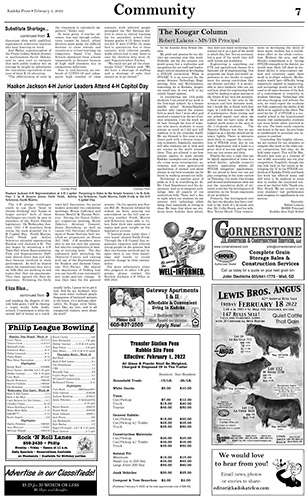 To the Kadoka Area School District,
To the Kadoka Area School District,
My pride and passion for our district are running over this week. Probably not for the reasons you would guess, but a realization and recognition for our staff and leadership’s critical mission in developing a STEAM curriculum. What is STEAM? It is an acronym for the terms: Science, Technology, Engineering, Arts, and Mathematics; something we at Kadoka, despite our small size, do very well, in my utterly biased opinion.
In considering our 11th-grade students, I am proud of our work in the first-topic subject. As a former middle school Science/English teacher who enjoyed the science field so much that I went after and received a master’s in the art of science education. I see the work we do here through the lens of someone who wants students to enjoy science as much as I did and will continue to in the everyday world. We are blessed to live near a national park with a diverse ecosystem to observe. Regularly, teachers will take students out to view and see science in the world around them. They are allowed to see how science applies in work outside Kadoka: examples such as drug trials crime scene investigation astronomy and even agricultural applications of animal and plant science in our local economy can be found by walking around our halls. Technology is another point of pride as it is in everything we do. Mr. Chad Eisenbraun and his department lead us to integrate technology into all aspects of our curriculum fully. There isn’t a day or night when our students do not interact with technology while doing their homework or sitting in class. We hope that when our students leave Kadoka Area school, they don’t just know technology but instead see it as a part of the world in which they live. Not an accessory, but a part of the world they will craft within our workforce.
Engineering is something our CTE and agricultural classes do a fantastic job of implementing. Our programs can boast real-world experiences in our faculty to supplement the strong curriculum that our district provides. It is invaluable to have students who can see and hear what the engineering field could be leading to great success in the future of our local job economy. Next would be the arts in the acronym and their fantastic work but I would like to finish with that topic, so I will first consider the M of mathematics. State testing and our school report card show the public that we have some of the highest math scores in the area in 11th-grade students. The Smarter Balance test that we are judged on as a district should not be taken lightly. There is intensive work daily to support the curriculum of STEAM every day in our math department, and it leads to a great deal of success spilling over.
into our test scores and data.
Finally, the arts, a topic that can be lightly appreciated at times in a school district, upholds content’s creative application within all STEAM categories’ applications. We are proud to have our one-act play competing in the state contest on Thursday this week. Our drama and musical performances show not just the cumulative skills of talented youth but the development of creativity in the future employees of our workforce.
Primarily, this development over the last two decades has been credited to the work of a dynamic arts duo, Mr. Colby Shuck, and his wife, Mrs. Teresa Shuck. Their commitment to developing the skills of their music students has a trickle-down effect on the whole curriculum. Without the arts, and Shuck’s commitment to it, having STEAM strength in the district, we would most likely fall short in students’ ability to cross-connect con- tent and creatively apply their work in multiple subjects. Mathematics would have difficulty being cognitively applied to engineering, and technology would not be fully used in all topics because of the lack of a commitment to creativity in student thinking. Technology will not stop changing, and without the arts, we could expect the students not fully appreciate the ability of all skills to be applied to the other. The need for the ‘A’ of STEAM in a successful school is the hypothesized reason that mathematics students can score better when involved in the arts. The brain easily connects one lesson to the next. An arts brain is conditioned to associate one sequence with another.
Concluding this lengthy column, we are excited for our students to compete this week at the state one- act competition, but alas, we do hold some regret. This will be Mrs. Shuck’s last year as a director of our wildly successful one-act competition. Hopefully, though, she can look back on her career in developing the ‘A’ in the STEAM curriculum of Kadoka Public and know her work has affected many and will need to be replaced in some way to realize the continued success of our district fully. Thank you, Mrs. Shuck. We are excited to see your students’ last performance and recognize its significance in our success.
Sincerely,
Robert Lukens MS/HS Principal
Kadoka Area High School
